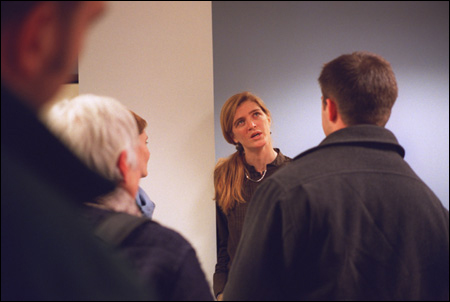Remaining ‘objective’ in the face of human suffering
Samantha Power discusses dilemma of journalists

Reporters covering tragedies in the world’s forgotten places face a host of hurdles on the ground, from language gaps to difficulties with travel, but once they have the story, their toughest challenge may be selling it to editors, according to Samantha Power, lecturer at the John F. Kennedy School of Government.
Power, author of the Pulitzer Prize-winning book “A Problem From Hell: America and the Age of Genocide,” described the challenges facing journalists seeking to cover conflicts around the world. She spoke at a talk at the Kennedy School’s Shorenstein Center on the Press, Politics and Public Policy.
Power, who covered the war in the former Yugoslavia from 1993 to 1996 for a variety of publications, also discussed the sometimes blurry line between straightforward reporting of a story and advocacy journalism, such as her own work in the human rights arena.
Shorenstein Center Director Alex Jones introduced Power, saying “A Problem From Hell” shed light onto an area the public didn’t properly understand.
“Samantha Power has made an enormous contribution to the public understanding and public awareness of something that has been [poorly] understood,” Jones said.
The talk, “Reporting Atrocity: War, Neutrality and the Danger of Taking Sides,” was part of a series of symposia taking place across the nation in memory of slain Wall Street Journal reporter Daniel Pearl called “Press Under Fire.”
In covering the atrocities against civilians in the former Yugoslavia, Power said reporters soon realized that the conflict was so one-sided that it would be difficult to present a view that was “balanced.” They also soon realized that, though atrocities were being perpetrated by both sides, a simple reporting of the facts would paint one side as the aggressor.
“Your job is to be truthful to the proportions,” Power said.
It also takes some time, she said, to get over the “Nah” factor, or the unwillingness to believe the senseless killing of innocents is in fact going on. The first reaction of reporters, she said, is to frame the story against a backdrop of ancient ethnic tensions, civil war, or ongoing disputes between two groups.
Many reporters, Power said, don’t make the switch to advocacy as she did. Using journalism as a tool to press for change has additional risks and could provoke the ire of those on the other side of the dispute.
A major challenge for any reporter covering a conflict, Power said, is selling the story to an editor. Today, she said, any story with a link to America’s war on terror has a willing audience. But many stories, such as the collapse of Zimbabwe and the African AIDS crisis, are harder to sell.
Particularly difficult, she said, are stories like that in Sudan, where years of conflict have made human tragedy and atrocity a routine occurrence. A reporter has to work doubly hard to find news links, such as visiting delegations or particularly horrendous atrocities, to make it into the pages of publications in the United States and in other nations.
The practical challenges of reporting in these circumstances can also be daunting. Operating in war-torn countries can mean hiring bodyguards and usually means putting trust in a local person familiar with the situation. Language barriers may dictate hiring a translator, and safety concerns could require operating in armored vehicles.
In addition, work must often be performed under the guidance of government handlers, who may accompany reporters as a condition of being allowed to enter a conflict area. Reporters may also be in physical danger, as illustrated by the death of Pearl and other journalists covering conflicts.
The reluctance of news executives to invest resources in covering a long-simmering story makes the task more difficult for a reporter sent in to cover the situation when violence escalates. The reporter may have little understanding of the regional culture or the historical underpinnings of the situation, putting her at the mercy of official sources, which can be reflected in the early coverage of a crisis.
Power used her own story to illustrate her points and described working as a stringer for several publications in the former Yugoslavia. Though it won a Pulitzer after publication, she had a difficult time selling her book and survived on various fellowships during the seven years it took to write.
“It was really, really challenging,” Power said of her work in the former Yugoslavia. “We always felt we were just days away from stopping it all [by getting other nations involved in the conflict]. That’s what kept us at it.”




